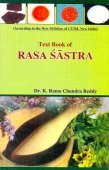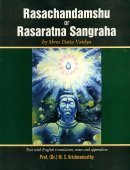Valukayantra, Valuka-yantra, Vālukayantra: 5 definitions
Introduction:
Valukayantra means something in Hinduism, Sanskrit, Marathi. If you want to know the exact meaning, history, etymology or English translation of this term then check out the descriptions on this page. Add your comment or reference to a book if you want to contribute to this summary article.
In Hinduism
Ayurveda (science of life)
Rasashastra (Alchemy and Herbo-Mineral preparations)
Source: Academia.edu: Ayurveda and Pharmaceutics (rasashastra)Vālukayantra (sand apparatus): A wide mouth earthen vessel is punctured at its bottom to form 3-5 small holes. These holes are made so as to ensure that the lower surface of the glass vessel gets controlled heat when the equipment is placed on fire. This glass vessel is half-filled with the medicine mixture is then covered or bandaged with cloth soaked in mud/clay. The glass vessel containing kajjali (mixture of mercury and sulphur) is heated for many hours. The sand used gives controlled heat to the glass container. The medicines made in this technique are known as sindhūra-auṣadas.

Āyurveda (आयुर्वेद, ayurveda) is a branch of Indian science dealing with medicine, herbalism, taxology, anatomy, surgery, alchemy and related topics. Traditional practice of Āyurveda in ancient India dates back to at least the first millenium BC. Literature is commonly written in Sanskrit using various poetic metres.
Languages of India and abroad
Marathi-English dictionary
Source: DDSA: The Molesworth Marathi and English Dictionaryvālukāyantra (वालुकायंत्र).—n (S Sand-machine.) A sand glass or vessel for measuring time.
Source: DDSA: The Aryabhusan school dictionary, Marathi-Englishvālukāyantra (वालुकायंत्र).—n A sand-glass for measuring time.
Marathi is an Indo-European language having over 70 million native speakers people in (predominantly) Maharashtra India. Marathi, like many other Indo-Aryan languages, evolved from early forms of Prakrit, which itself is a subset of Sanskrit, one of the most ancient languages of the world.
Sanskrit dictionary
Source: DDSA: The practical Sanskrit-English dictionaryVālukāyantra (वालुकायन्त्र).—a sand-bath.
Derivable forms: vālukāyantram (वालुकायन्त्रम्).
Vālukāyantra is a Sanskrit compound consisting of the terms vālukā and yantra (यन्त्र).
Source: Cologne Digital Sanskrit Dictionaries: Monier-Williams Sanskrit-English DictionaryVālukāyantra (वालुकायन्त्र):—[=vālukā-yantra] [from vālukā > vālu] n. a sand-bath, [Bhāvaprakāśa]
Sanskrit, also spelled संस्कृतम् (saṃskṛtam), is an ancient language of India commonly seen as the grandmother of the Indo-European language family (even English!). Closely allied with Prakrit and Pali, Sanskrit is more exhaustive in both grammar and terms and has the most extensive collection of literature in the world, greatly surpassing its sister-languages Greek and Latin.
See also (Relevant definitions)
Partial matches: Valuka, Yantra.
Query error!
Relevant text
Search found 9 books and stories containing Valukayantra, Valuka-yantra, Vāluka-yantra, Vālukā-yantra, Vālukayantra, Vālukāyantra; (plurals include: Valukayantras, yantras, Vālukayantras, Vālukāyantras). You can also click to the full overview containing English textual excerpts. Below are direct links for the most relevant articles:
World Journal of Pharmaceutical Research
Comprehensive appraisal of rasasindura- a kupipakva rasayana in indian alchemy < [2021: Volume 10, February issue 2]
Talasindura – a literary review < [2022: Volume 11, October issue 13]
Comparative study of rasasindoor with single and dual kanchkupi. < [2018: Volume 7, September issue 16]
International Ayurvedic Medical Journal
Kupipakwa rasayana- an exploration of the classics < [2018, Issue VI, June]
Tamra sindoora – pharmaceutico analytical study < [2020, Issue 4, April]
Pharmaceutico analytical study of lohagarbha pottali < [2017, Issue VII, July]
Pharmaceutical standardization of samaguna and shadaguna balijarita rasa sindura < [Volume 7, Issue 5: September - October 2020]
In vitro antimicrobial activity of tal sindoor < [Volume 1, issue 1: September - October 2014]
Pharmaceutico-analytical study of anilari ras: a herbo mineral compound < [Volume 3, issue 1: Jan- Feb 2016]
Chemistry of Kupipakwa Rasayanas – A Review < [Volume 27 (issue 4), Apr-Jun 2008]
Chemical Analysis of Vasantakusumākara Rasa for Quality Assurance < [Volume 36 (issue 4), Apr-Jun 2017]
Standardization of Samaguna Bali Jarita Rasasindura methods. < [Volume 31 (issue 3), Jan-Mar 2012]
Journal of Ayurveda and Holistic Medicine
Pharmaceutical and analytical study of Khageshwara Rasa < [Volume 11, issue 12 (2023)]
A Critical study of Somanathi Tamra Bhasma- A mercuro-arsenical formulation < [Volume 12, issue 7 (2024)]
Tamra sindoora : a conceptual framework and empirical exploration < [Volume 4, issue 6 (2016)]
Notices of Sanskrit Manuscripts (by Rajendralala Mitra)
Page 230 < [Volume 6 (1882)]
Related products

